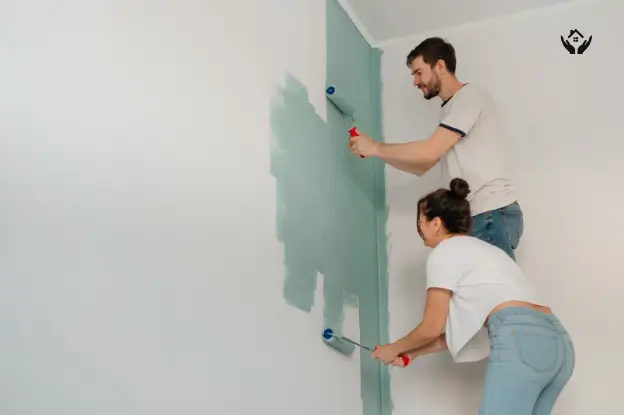When refreshing your home’s walls, the type of paint you choose matters far more than just the color. Many conventional paints contain chemicals that silently impact your indoor air quality long after that “fresh paint smell” disappears.
Low-VOC paints offer a healthier alternative for homeowners concerned about their family’s well-being and environmental impact. These specially formulated paints significantly reduce harmful emissions while still providing beautiful, long-lasting results.
Let’s explore how making this simple switch can transform your living space into a healthier, more environmentally friendly home.
Understanding Low-VOC Paints and Their Impact on Your Living Space
Before diving into the advantages, it’s essential to understand exactly what low-VOC paints are and how they differ from conventional options.
What Defines Low-VOC Paints and How They Differ from Traditional Options
Low-VOC paints contain significantly fewer volatile organic compounds than traditional paints. VOCs are chemicals that evaporate at room temperature, releasing potentially harmful gases into your home’s air. While conventional paints might contain up to 250 grams of VOCs per liter, low-VOC options typically contain less than 50 grams per liter.
This dramatic reduction means fewer toxic chemicals enter your living space during and after the painting process. Many Atlanta homeowners are making the switch to these healthier paint options. Professional house painters Atlanta often recommend low-VOC products, especially for indoor spaces where proper ventilation might be limited or for households with sensitive members.
The Science Behind VOC Emissions and Their Indoor Concentration Levels
According to the EPA, indoor VOC levels can be up to five times higher than outdoor levels, and these concentrations can persist long after painting is complete. The science is concerning—these compounds don’t just disappear once the paint dries. Traditional paints can continue off-gassing VOCs for years, contributing to a subtle but persistent decline in your home’s air quality.
Key Certifications and Standards to Look for When Purchasing Low-VOC Products
When shopping for healthier paint options, look for trusted certifications like Green Seal, GREENGUARD, or MPI Green Performance. These independent organizations verify that products meet strict standards for VOC content and emissions. The most stringent certifications limit VOCs to as little as 10 grams per liter, providing significant benefits of low-VOC paints for your home environment.
Remarkable Health Advantages of Low-VOC Paint Solutions
The health benefits of choosing low-VOC options extend far beyond just reducing chemical exposure. These paints can actively contribute to a healthier home environment in several important ways.
Respiratory Benefits for Allergy and Asthma Sufferers
For those with respiratory conditions, traditional paint fumes can trigger serious symptoms. Low-VOC paints significantly reduce these risks by minimizing irritating chemicals in the air. A 2023 study published found that using low-VOC paints contributed to a decrease in reported respiratory symptoms among homeowners who completed renovations.
Protection for Vulnerable Household Members
Children, seniors, and pets are particularly susceptible to VOC exposure due to developing immune systems or age-related vulnerabilities. Their smaller bodies process chemicals differently, making low-VOC paints an essential choice for households with vulnerable members. These paints help create spaces where everyone can thrive without unnecessary chemical exposure.
Reduction in Headaches, Eye Irritation, and Other Common Paint-Related Symptoms
Traditional paint projects often come with unwanted side effects—headaches, dizziness, and eye irritation chief among them. By choosing low-VOC paints, you can dramatically reduce these uncomfortable symptoms during and after your painting project, making the entire process more pleasant for everyone involved.
Long-Term Health Benefits of Maintaining Superior Indoor Air Quality
Perhaps most importantly, the benefits continue long-term. By decreasing the chemical load in your living spaces, low-VOC paints help maintain better indoor air quality throughout your home. This ongoing advantage supports overall family wellness year after year.
Environmental Impact of Choosing Low-VOC Paint Alternatives
The positive effects of low-VOC paint extend well beyond your home’s walls to benefit the broader environment.
Reducing Your Carbon Footprint Through Sustainable Paint Choices
Traditional paints contribute significantly to atmospheric VOC emissions, which play a role in forming ground-level ozone and smog. By selecting eco-friendly paint options, you’re helping reduce these harmful emissions. Homes using low-VOC materials experienced a reduction in indoor air pollutants, proofing that how individual choices contribute to environmental improvements.
How Low-VOC Products Contribute to Decreased Air Pollution
VOCs released during painting and curing don’t just affect your home—they contribute to regional air quality issues. Low-VOC products significantly reduce this pollution source, helping create cleaner air for everyone in your community. It’s a small change that collectively makes a substantial difference.
Lifecycle Analysis
Many low-VOC paint manufacturers also implement more sustainable production practices and use water-based formulas that reduce environmental harm throughout the product lifecycle. From manufacturing to application to eventual disposal, these paints typically have a lighter environmental footprint.
Sustainability Initiatives
By purchasing low-VOC paints, you’re voting with your dollars for a more sustainable industry. Manufacturers respond to consumer demand, and the growing popularity of these products has encouraged broader adoption of environmentally responsible practices throughout the paint industry.
Performance Comparison: How Low-VOC Paints Stand Up Against Traditional Options
Early low-VOC formulas sometimes sacrificed performance for health benefits, but today’s options have largely closed this gap.
Modern low-VOC paints have benefited from significant technological advancements. Manufacturers have refined their formulations to provide excellent coverage, color saturation, and application properties without relying on harmful VOCs. Reports said that 40% of consumers now prioritize low-VOC options when choosing paint, driving further innovation in this category.
Durability, Coverage, and Color Retention Properties
Today’s low-VOC paints often match or exceed conventional paints in durability tests. Their ability to resist fading, staining, and wear has improved dramatically, making them suitable for high-traffic areas throughout your home. Most options now provide comparable coverage to traditional paints, requiring similar numbers of coats for professional-looking results.
Application Techniques for Optimal Results With Low-VOC Products
While application techniques are similar to traditional paints, some low-VOC products may have slightly different drying times or flowing properties. Working with thin, even coats typically yields the best results. Many professional painters have adapted their techniques to maximize the performance of these healthier alternatives.
Cost Considerations and Long-Term Value Assessment
While low-VOC paints might cost slightly more upfront (typically 10-20% more than conventional options), their value proposition extends beyond price alone. The health benefits, improved indoor air quality, and comparable durability make them a worthwhile investment for most homeowners.
Your Questions About Low-VOC Paints Answered
-
Are low-VOC paints more expensive than traditional options?
Low-VOC paints typically cost 10-20% more than conventional paints, but prices have decreased as they’ve become more mainstream. The health benefits and comparable durability make them worth the modest premium for most homeowners concerned about indoor air quality.
-
How long should ventilate home after applying low-VOC paint?
Even with low-VOC paints, proper ventilation helps the curing process and removes any minimal odors. Aim for 24-48 hours of good airflow, though you can typically occupy the space much sooner than with traditional paints without experiencing irritation.
-
Can we achieve the same vibrant colors with low-VOC paints?
Absolutely! Modern low-VOC formulations offer the same rich color palette as conventional paints. Current technology allows manufacturers to create vibrant, lasting colors without relying on VOC-heavy ingredients that were once necessary for certain pigments.
Creating Healthier Spaces Through Informed Paint Choices
Making the switch to low-VOC paints represents a meaningful step toward creating a healthier home environment. These paints deliver significant advantages for your family’s well-being while also supporting broader environmental sustainability goals—all without sacrificing beauty or performance.
The evolution of paint technology has eliminated the need to choose between health and quality. Today’s low-VOC options provide excellent coverage, durability, and color selection while dramatically reducing harmful chemical emissions in your home.
By understanding the benefits of low-VOC paints, you can make informed decisions that protect your family’s health, support environmental sustainability, and create beautiful living spaces to enjoy for years to come. The next time you’re planning a painting project, remember that your paint choice affects much more than just how your walls look—it impacts how your home feels, breathes, and supports the well-being of everyone inside.




